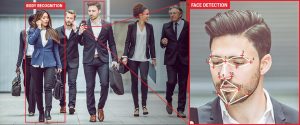Opportunity
The surveillance and security services industry in North America recorded revenues around $34 bn in 2017 and is constantly growing. A significant part of this comes from security services in private enterprises, especially for small and medium sized enterprises, where shoplifting is a large concern. For an average store for each item stolen they have to sell 50 more of the same product in order to make up for the loss. Machine learning techniques and feedback loops can help human-machine ensembles solve this problem. Smart sensors can alert human surveillance centers, allowing organisations to devote less resources towards security. Moreover, analyzing behaviour using these mechanisms will allow security companies and businesses to reduce costs incurred through thefts.
Proposal
We will provide a minimal number of video cameras to each store. The cameras will be embedded with video recognition software that can process and analyze movements, postures and behavior patterns. Smart sensors will complement our cameras by being able to record ambient information such as the number of people in store and temperature.
This will in part be in areas where behavior is necessitated to be monitored. The cameras will be able to provide real-time alerts when suspicious behavior is observed, which can be integrated with a smartphone to be able to swiftly respond. The system will also be able to monitor safety related behaviors and send alerts to law enforcers. For example the system will immediately alert the police and send them footage if it detects an individual who is unlawfully carrying a weapon.
Another potential future use case that be leveraged in addition to the security feature would be to roll an autonomous retail store experience for customers visiting the store. To facilitate this service, retailers could create smart contracts that would authorize automated payments, discounts and enforce rules against returns or disputes depending on the customer’s attributes (e.g loyal customers gets rewards and more wiggle room etc..). This would eliminate the need for a human at the retail store and eliminate wait times at check-outs and dramatically mitigate a major felon amongst shoplifters — “sweethearting” — the collusion of a shoplifter and the checkout clerk.
Empirical Demonstration of Commercial value and promise
The cost savings that will occur from this product will be immense for businesses that regularly experience shoplifting or errors to their products. This would eliminate the need for a human or a conventional sensor whom would not have the same accuracy as our product in capturing the people with unpaid items leaving their store. In addition, this would make it harder for the employee to manipulate for his own self.
Furthermore, the product does not violate the privacy of the customers visiting the store as it is merely a surveillance camera that records the movement and behavior of the individuals in the store. This could expand to monitor other unwanted behaviors such as terrorism, reckless driving and any other behavior that is valuable to be reported to the business or organization to enable them to take action. The real value comes from the ability to report in real-time rather than the retrospective method used from a conventional camera’s past records especially for behaviors that need a swift response.

Perhaps the one added-value feature that would be revolutionary for law enforcers would be the ability to have superior facial recognition through these cameras. This would help law enforcers identify people in complicated situations where there is a large crowd and save them the time to repetitively watch the video for clues, saving them enormous resources that could be utilized to other areas.
Challenges
We think that it might be difficult to convince small businesses to equip themselves with our ZeroChain cameras and sensors when they do not realize the cost savings incurred by our product. Moreover, they would need to be convinced that our product actually works better than conventional tools already available in the market.
Our mitigation for this case would be that we could charge these businesses our equipment at cost and only charge them a marginal subscription fee. We would then charge them each time our camera successfully detects an individual that could have potentially incurred losses to the retailer. This would make our customers feel comfortable knowing that our interests are aligned with theirs. Additionally, big retailers such as Target have accelerators focused on retail technologies, and others such as Walmart have shown interested in investing in an autonomous and seamless customer experience through acquisitions by Walmart Labs.
Sources:
https://venturebeat.com/2017/11/22/ai-could-make-video-surveillance-a-proactive-crime-fighting-tool/
Team Members:
Mohammed Alrabiah
Tuneer De
Mikhail Uvarov
Colin Ambler
Lindsay Hanson
